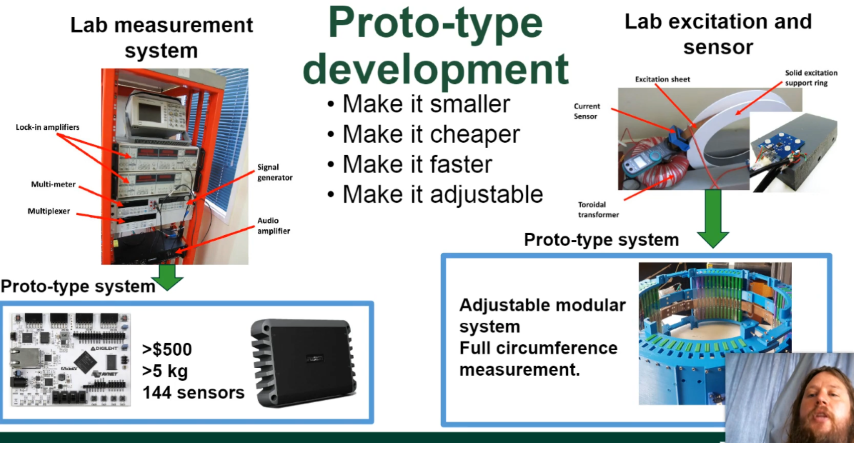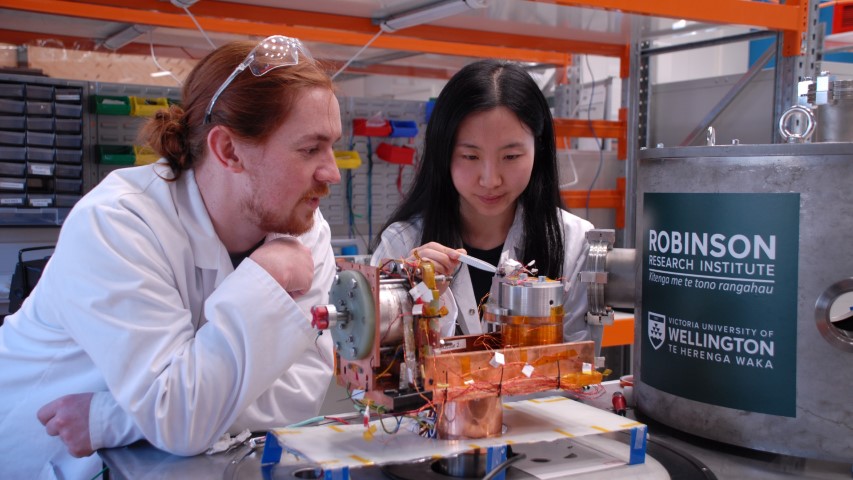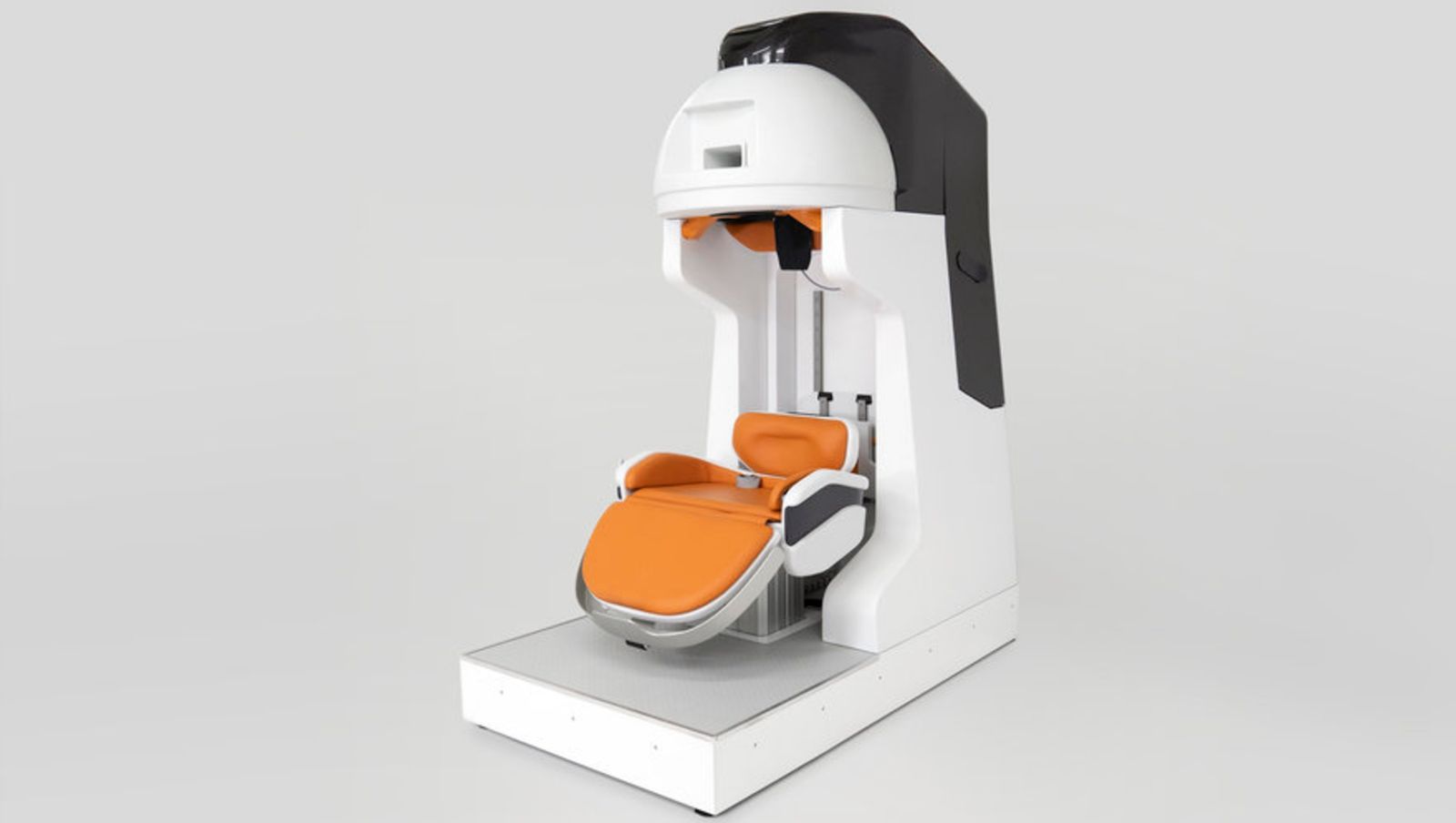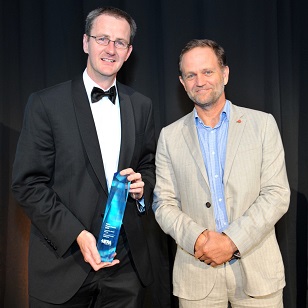2020
PhD student receives scholarship from Te Āti Hau Trust
16 December, Robinson Research Institute
Congratulations to Gus Brooks who last week received a PhD scholarship from Te Āti Hau Trust in Whanganui. Gus is undertaking his PhD at Robinson Research Institute, he is pictured with his supervisor Dr Rod Badcock and his father Kit Brooks.
2020 Tech Bootcamp
14-18 December, Robinson Research Institute
In December, Robinson Research Institute hosted its first Tech Bootcamp for Year 12-13 Māori and Pasifika students, in conjuction with our partners at Ferrier Institute, Victoria University Faculties of Engineering and Science, Callaghan Innovation and GNS Science. The Bootcamps aim to inspire young people to pursue a career in science and engineering. For more information contact rri‑postgrad@vuw.ac.nz
Joseph Bailey's Presentation at MaDE2020
7 December, MaDE Conference

See Joseph Bailey talk about the 'Development of a magnetic inspection tool for insulated steam pipes', presented at the 2020 Manufacturing Design and Entrepreneurship conference.
Robinson Research Institute aiming very, very high
2020, Victorious
The Robinson Research Institute is flying high when it comes to low-emission aircraft and future quests into space. Two major funding successes for the Institute will catapult the University into the vanguard of efforts to develop a decarbonised world.
Improving the MRI experience
2020, Victorious

Designing and building a magnetic resonance imaging (MRI) system is no easy undertaking, especially when you’re part of an international collaboration trying to make the system more accessible and comfortable.
Sustainable energy: Kiwi technology brings nuclear fusion closer to reality
24 November, New Zealand Herald
It's been called the holy grail of sustainable energy - and now Kiwi technology could help bring nuclear fusion closer to reality.
Robinson Research Institute hosts workshop on non-destructive testing for the power industry
18 November, Victoria University of Wellington
Organisations are increasingly becoming aware of the benefits of non-destructive testing methods when it comes to monitoring and managing the health of their assets. This is especially true of sectors that involve huge capital investments, maintenance and replacement costs.
Superconductor technology for smaller, sooner fusion
14 October, Phys.org
The high-field pathway to fusion, aims to generate fusion in compact devices on a shorter timescale and lower cost than alternative approaches.
Space Enthusiast and Professionals MeetUp (Wellington) - Electric Satellite Propulsion Technology
8 October, YouTube
Join us as Dr Nick Long from Robinson Research Institute at Victoria University discusses the recent success on a novel electric propulsion technology for satellites.
Magnetic attraction for space travel
1 October, Victoria University of Wellington
Future space missions may be propelled using superconductor magnets developed by the Robinson Research Institute.
Could this Kiwi-made tech help humans get to Mars?
30 September, NZ Herald
Engineers at Victoria University's Robinson Research Institute have begun a major project to apply the high-temperature superconductor materials they've pioneered to new ion thrusters, capable of propelling craft much further into space.
$15m government grant for electric planes, trains and ships research.
17 September, Radio New Zealand
The Ministry for Business, Innovation and Employment has awarded the Robinson Research Institute at Victoria University of Wellington funding to working on high-power electric motors for large-scale transport such as planes, trains and ships.
Save the planet with science — from New Zealand
17 September, Victoria University of Wellington

Calling New Zealand’s brightest! Exciting science doesn’t just happen in other countries. It’s being done in New Zealand, too. And you can get involved.
Novel Kiwi technology could make Mars attainable
15 September, Scoop
Robinson Research Institute, Victoria University of Wellington, is developing technology to revolutionise spacecraft propulsion, making it more efficient to propel rockets while in space.
2020 Endeavour Fund Success
14 September, Ministry of Buisiness, Innovation and Employment
The Robinson Research Institute's Endeavour fund proposal entitled 'High magnetic field electric propulsion for space' has been approved by the Ministry of Buisiness, Innovation and Employment. The funding awarded totals $11.6 million dollars over 5 years.
PhD student wins IEEE Best Paper Award
4 August, Robinson Research Institute

PhD student Anwarul Sifat and co-authors Fiona Stevens-McFadden, Ramesh Rayudu and Joseph Bailey were awarded Best Paper by the IEEE at the 2020 IEEE Kansas Power and Engineering Conference for their paper "Classification of Stages of a High Impedance Fault Using Sequential Learning Algorithms".
Researchers develop a head-only MRI system to make brain scans more comfortable
24 July, designboom
The seated solution intends to reduce anxiety thanks to a number of features, including a remote control for the patient and a window to see out of.
New head scanning machine designed to reduce anxiety
7 July, Radio New Zealand
Head scans in Magnetic Resonance Imaging, or MRI machines, should become more comfortable thanks to work being done by Wellington researchers.
Wellington researchers looking into making MRI more comfortable.
University researchers create innovative MRI technology
6 July, Victoria University of Wellington

In a collaboration between scientists and designers, Te Herenga Waka—Victoria University of Wellington researchers have developed new technology to make magnetic resonance imaging machines (MRIs) more comfortable, accessible, and affordable.
Materials: Fact or Fiction - Adamantium with Dr Chris Bumby
14 May, Radio New Zealand
Tonight Dr. Chris Bumby, Principal Scientist at Victoria University of Wellington’s Robinson Institute; and Associate Investigator at the MacDiarmid Institute gies us his scientific take on Adamantium - one of several ‘amazing materials’ which have been invented over the years by the authors of Marvel comics.
Materials: Fact or Fiction - Mithril with Dr Chris Bumby
19 March, Radio New Zealand
MacDiarmid Institute Associate Investigator and Senior Scientist at the Robinson Research Institute of Victoria University of Wellington give us his scietific take on Mithril from Lord of the Rings.
FLEET collaboration - Annual Report 2019
13 March, MacDiarmid Institute
Laying the groundwork for a low-energy computing revolution – MacDiarmid Institute researchers are partnering with Australia’s Monash University- based Centre of Excellence in Future Low-Energy Electronics Technologies (FLEET) to combine their nanoscale materials expertise with the Australians’ knowledge of advanced electronics design.
Robinson Research Institute’s hydrogen-steel making research wins Innovation Award
27 February, Victoria University of Wellington

Dr Chris Bumby, Principal Scientist, Robinson Research Institute, has received the HERA 2020 Innovation Award, in recognition of his work towards developing a hydrogen-ironmaking process. This novel process has the potential to eliminate carbon dioxide emissions from New Zealand’s steel industry.







